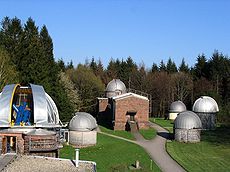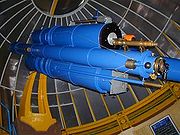
Landessternwarte Heidelberg-Königstuhl
Encyclopedia

Königstuhl (Odenwald)
The Königstuhl , translated "Kings seat", is a 567 metre high hill in the Odenwald Mountains and in the city of Heidelberg, in the German state of Baden-Württemberg. The Königstuhl summit allows visitors a spectacular view of the city of Heidelberg and the River Neckar as well as the Rhine Valley...
hill in the city of Heidelberg
Heidelberg
-Early history:Between 600,000 and 200,000 years ago, "Heidelberg Man" died at nearby Mauer. His jaw bone was discovered in 1907; with scientific dating, his remains were determined to be the earliest evidence of human life in Europe. In the 5th century BC, a Celtic fortress of refuge and place of...
in Germany
Germany
Germany , officially the Federal Republic of Germany , is a federal parliamentary republic in Europe. The country consists of 16 states while the capital and largest city is Berlin. Germany covers an area of 357,021 km2 and has a largely temperate seasonal climate...
. The predecessor of the current observatory was originally opened in 1774 in the nearby city of Mannheim
Mannheim
Mannheim is a city in southwestern Germany. With about 315,000 inhabitants, Mannheim is the second-largest city in the Bundesland of Baden-Württemberg, following the capital city of Stuttgart....
but degradation of observational conditions there resulted in a relocation to the Königstuhl in 1898.
The observatory forms part of the Center of Astronomy
Center of Astronomy (University of Heidelberg)
The Zentrum für Astronomie der Universität Heidelberg in Heidelberg, Germany, founded in 2005, is an association of three, formerly state-run research institutes: the Astronomisches Rechen-Institut, the Institut für Theoretische Astrophysik and the Landessternwarte Heidelberg-Königstuhl...
of the University of Heidelberg
Ruprecht Karl University of Heidelberg
The Ruprecht-Karls-Universität Heidelberg is a public research university located in Heidelberg, Baden-Württemberg, Germany. Founded in 1386, it is the oldest university in Germany and was the third university established in the Holy Roman Empire. Heidelberg has been a coeducational institution...
. The Max Planck Institute for Astronomy
Max Planck Institute for Astronomy
The Max-Planck-Institut für Astronomie is a research institute of the Max Planck Society. It is located in Heidelberg, Baden-Württemberg, Germany near the top of the Koenigstuhl, adjacent to the historic Landessternwarte Heidelberg-Königstuhl astronomical observatory.The institute was founded in...
opened on an adjacent site in 1967.
The current director (since 2006) is Andreas Quirrenbach.
History
The instrumentation of the observatory originated from the Mannheim ObservatoryMannheim Observatory
The Mannheim Observatory was a tower observatory built between 1772 and 1774 in Mannheim, Germany, which remained in operation until 1880. The observatory was transferred to Karlsruhe and finally in 1898, was established on the Königstuhl near Heidelberg where today’s successor institution thr...
, founded in 1774. In 1880 the observatory was provisionally moved to Karlsruhe
Karlsruhe
The City of Karlsruhe is a city in the southwest of Germany, in the state of Baden-Württemberg, located near the French-German border.Karlsruhe was founded in 1715 as Karlsruhe Palace, when Germany was a series of principalities and city states...
because the astronomical/atmospherical seeing
Astronomical seeing
Astronomical seeing refers to the blurring and twinkling of astronomical objects such as stars caused by turbulent mixing in the Earth's atmosphere varying the optical refractive index...
conditions worsened. In subsequent years, three other locations were considered, with Heidelberg-Königstuhl
Königstuhl (Odenwald)
The Königstuhl , translated "Kings seat", is a 567 metre high hill in the Odenwald Mountains and in the city of Heidelberg, in the German state of Baden-Württemberg. The Königstuhl summit allows visitors a spectacular view of the city of Heidelberg and the River Neckar as well as the Rhine Valley...
finally being chosen.
On 20 June 1898 the "Großherzogliche Bergsternwarte" was ceremonially inaugurated by Frederick I, Grand Duke of Baden. The astronomical institute comprised two complementary departments, the astrophysical, led by Max Wolf
Max Wolf
Maximilian Franz Joseph Cornelius Wolf was a German astronomer and a pioneer in the field of astrophotography...
, and the astrometrical
Astrometry
Astrometry is the branch of astronomy that involves precise measurements of the positions and movements of stars and other celestial bodies. The information obtained by astrometric measurements provides information on the kinematics and physical origin of our Solar System and our Galaxy, the Milky...
led by Karl Wilhelm Valentiner
Karl Wilhelm Valentiner
Karl Wilhelm Valentiner was a German astronomer.-Life:In 1874, Wilhelm Valentiner lead a successful German expedition to Tschifu to observe a solar eclipse. 1875, He took over the directorship of the Mannheim Observatory in 1875...
. Valentiner was director of the Mannheim observatory and initiated the move to Karlsruhe. After Valentiner's retirement in 1909, both departments were placed under the administration of Max Wolf.

Max Wolf
Maximilian Franz Joseph Cornelius Wolf was a German astronomer and a pioneer in the field of astrophotography...
obtained a grant of $10,000 from the American philanthropist Catherine Wolfe Bruce
Catherine Wolfe Bruce
Catherine Wolfe Bruce was a noted American philanthropist and patroness of astronomy.She was the daughter of the famous type founder George Bruce and Catherine Wolfe...
for the acquisition of a powerful new dual 16 in (40.6 cm) refractor telescope, the Bruce double astrograph
Astrograph
An astrograph is a telescope designed for the sole purpose of astrophotography. Astrographs are usually used in wide field surveys of the night sky as well as detection of objects such as asteroids, meteors, and comets.-Design:...
. For many years this telescope was the observatory's main research instrument. He later obtained a grant to build the observatory's a 28 in (71.1 cm) reflector telescope, the observatory's first.
The main field of activity of the observatory was the investigation of nebula
Nebula
A nebula is an interstellar cloud of dust, hydrogen gas, helium gas and other ionized gases...
e and the search for asteroids. Wolf, his staff and his successors discovered over 800 asteroids, including the first trojan asteroid
Trojan asteroid
The Jupiter Trojans, commonly called Trojans or Trojan asteroids, are a large group of objects that share the orbit of the planet Jupiter around the Sun. Relative to Jupiter, each Trojan librates around one of the planet's two Lagrangian points of stability, and , that respectively lie 60° ahead...
Achilles
588 Achilles
588 Achilles is an asteroid discovered on February 22, 1906, by the German astronomer Max Wolf. It was the first of the trojan asteroids to be discovered, and is named after Achilles, the fictional hero from the Iliad. It orbits in the Lagrangian point of the Sun-Jupiter system...
in 1906.
The observatory ceased to be run by the German federal government in 2005 when it was joined with the Institute of Theoretical Astrophysics and Astronomical Calculation Institute
Astronomical Calculation Institute (University of Heidelberg)
The Astronomisches Rechen-Institut , or ARI, is a research institute in Heidelberg, Germany. The ARI is currently part of the Zentrum für Astronomie der Universität Heidelberg ". Formerly, the ARI belonged to the state of Baden-Württemberg.The ARI has a rich history...
to make up the Center of Astronomy
Center of Astronomy (University of Heidelberg)
The Zentrum für Astronomie der Universität Heidelberg in Heidelberg, Germany, founded in 2005, is an association of three, formerly state-run research institutes: the Astronomisches Rechen-Institut, the Institut für Theoretische Astrophysik and the Landessternwarte Heidelberg-Königstuhl...
of the University of Heidelberg.
Between 1912 and 1957 Karl Wilhelm Reinmuth
Karl Wilhelm Reinmuth
Karl Wilhelm Reinmuth was a German astronomer.He was a prolific discoverer of asteroids , beginning with 796 Sarita in 1914, working at the Landessternwarte Heidelberg-Königstuhl astronomical observatory on the Königstuhl hill above Heidelberg, Germany from 1912 to 1957.His most notable...
discovered almost 400 asteroid
Asteroid
Asteroids are a class of small Solar System bodies in orbit around the Sun. They have also been called planetoids, especially the larger ones...
s from the Landessternwarte Heidelberg-Königstuhl.
External links
- Official observatory website (German/English)

